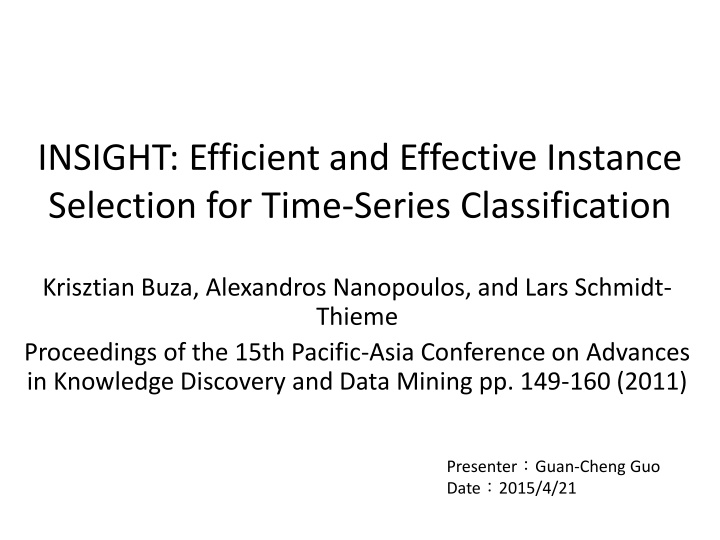
Effective Time-Series Instance Selection Method for Improved Classification
"Discover a novel instance selection technique leveraging hubness phenomenon for optimized time-series classification. Explore the INSIGHT framework's enhanced accuracy and reduced execution times compared to FastAWARD method."
Download Presentation

Please find below an Image/Link to download the presentation.
The content on the website is provided AS IS for your information and personal use only. It may not be sold, licensed, or shared on other websites without obtaining consent from the author. If you encounter any issues during the download, it is possible that the publisher has removed the file from their server.
You are allowed to download the files provided on this website for personal or commercial use, subject to the condition that they are used lawfully. All files are the property of their respective owners.
The content on the website is provided AS IS for your information and personal use only. It may not be sold, licensed, or shared on other websites without obtaining consent from the author.
E N D
Presentation Transcript
INSIGHT: Efficient and Effective Instance Selection for Time-Series Classification Krisztian Buza, Alexandros Nanopoulos, and Lars Schmidt- Thieme Proceedings of the 15th Pacific-Asia Conference on Advances in Knowledge Discovery and Data Mining pp. 149-160 (2011) Presenter Guan-Cheng Guo Date 2015/4/21
Abstract Time-series classification is a widely examined data mining task with various scientific and industrial applications. Recent research in this domain has shown that the simple nearest-neighbor classifier using Dynamic Time Warping (DTW) as distance measure performs exceptionally well, in most cases outperforming more advanced classification algorithms. Instance selection is a commonly applied approach for improving efficiency of nearest-neighbor classifier with respect to classification time. This approach reduces the size of the training set by selecting the best representative instances and use only them during classification of new instances.
Abstract In this paper, we introduce a novel instance selection method that exploits the hubness phenomenon in time-series data, which states that some few instances tend to be much more frequently nearest neighbors compared to the remaining instances. Based on hubness, we propose a framework for score-based instance selection, which is combined with a principled approach of selecting instances that optimize the coverage of training data. We discuss the theoretical considerations of casting the instance selection problem as a graph-coverage problem and analyze the resulting complexity. We experimentally compare the proposed method, denoted as INSIGHT, against FastAWARD, a state-of-the-art instance selection method for time series. Our results indicate substantial improvements in terms of classification accuracy and drastic reduction (orders of magnitude) in execution times.
FastAWARD Algorithm Training set T Na ve Rank Reduction: leave-one-out 1-NN classification on T Rank the instances according to the score function: Keep the n highest ranking instances in S as the training set for future classification.
Score Functions For a data set ? we define the k-occurrence of an instance ? ?, denoted ?? instances of ? having ? among their ? nearest neighbors. ?? , that is the number of ?? Define good (bad) k-occurrence of a time series x, ?? (and ?? time series that have ? as one of their good (bad) k- nearest neighbors. ?? respectively), which is the number of other
Score Functions Good 1-occurrence score: 1? ??? = ?? Relative score: 1? ?? 1? + 1 ??? = ?? Xi s score: 1? 2?? 1? ???? = ??
INSIGHT Algorithm Instance Selection based on Graph-coverage and Hubness for Time-series (INSIGHT).
Experiments Examine the performance of INSIGHT algorithm with the FastAWARD. The number of selected instances is equal to 10% of the size of the training set.
Experiments Compare the performance of different score function.
